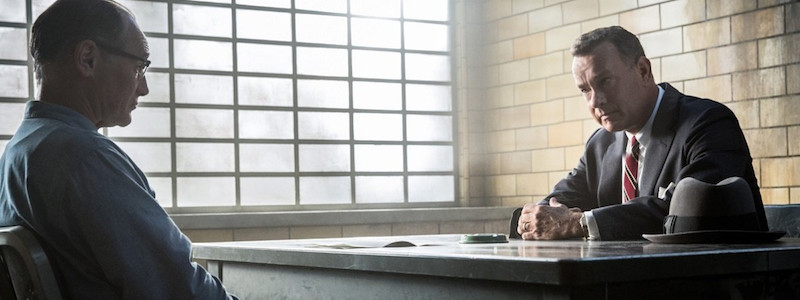
ReelBob: Bridge of Spies
By Bob Bloom
Something magical happens when director Steven Spielberg and actor Tom Hanks collaborate on a film.
And it especially shows when the subject of the movie is American history — a passion of both artists.
Thus it is with “Bridge of Spies,” a Cold War thriller, inspired by true events involving the 1957 capture and imprisonment of Soviet Union spy Rudolf Abel  and the later shooting down and capture by the Soviets of American U-2 spy plane pilot Francis Gary Powers.
and the later shooting down and capture by the Soviets of American U-2 spy plane pilot Francis Gary Powers.
Hanks portrays James Donovan, an insurance attorney, drafted by the U.S. government to represent Abel at his trial. The government simply wants to go through the motions of a fair trial for Abel, but Donovan actually works to defend his client to the best of his ability.
That he fails and Abel is convicted is unimportant. What does matter is that Donovan convinces the trial judge not to give Abel the death penalty — reminding him that one day an American spy could be in the same situation and Abel could be used as a bargaining chip.
That day finally arrives when Powers is in Soviet custody.
The CIA recruits Donovan to act as a private citizen and arrange a swap of spies.
Donovan travels to Berlin where tensions are high because the Soviets are building a wall to separate the East and West sectors of the city and keep Germans from fleeing to the West.
Complications arise when East Berlin authorities capture and jail an American graduate student and also want a say in the Abel-Powers swap to gain formal recognition from the United States.
“Bridge of Spies” is rich in historical perspective. The anger and paranoia in the U.S. about the Soviets and their intentions are at a fever pitch.
Schools are conducting duck-and-cover drills in case of atomic attack, and people look askance at anyone who even associates with a Russian.
This all makes Hanks performance as a regular citizen even more heroic and impressive. He uses the skills lawyers know best — the power of reason and persuasion to keep a lid on the volatile situation and affect the trade. He even convinces the East Berlin authorities that making the grad student part of the exchange would be in their best interests.
The film does have a couple of sore points. One is the overly melodramatic stridency in the first act in which the judge and prosecutors attempt to sway Donovan not to capably represent his client.
Another is the portrayal of a contingent of CIA agents: They are nearly buffoonish and seem as if they stepped out of some comic spoof of the era.
What is truly remarkable about “Bridge of Spies” is that, other than Donovan, Abel is the film’s most honorable and sympathetic person.
That is due to the strong performance of Mark Rylance, who brings a quiet dignity and a strong professionalism to his characterization. When U.S. agents try to convince him to switch sides to avoid prison and possibly execution, he refuses.
As a worried Donovan tells Soviet authorities as the swap is underway, Abel stayed true and did not betray his homeland.
At nearly 135 minutes, “Bridge of Spies” moves at a steady pace that holds your attention.
With tensions between the United States and Russia again on the rise, with both nations today having aircraft in the skies in the Middle East, “Bridge of Spies” is a timely history lesson about an era when two superpowers clawed, scratched and suspiciously eyed each other over their nuclear arsenals.
Thankfully, both were too smart to use those weapons. Perhaps this thrilling Spielberg-Hanks collaboration can serve as a reminder of how close to the brink these nations came before cooler heads and minds prevailed.
Bloom is a member of the Indiana Film Journalists Association. His reviews appear at ReelBob (reelbob.com) and The Film Yap (filmyap.com). He also reviews Blu-rays and DVDs. He can be reached by email at bobbloomjc@gmail.com or on Twitter @ReelBobBloom. Other reviews by Bloom can be found at Rottentomatoes: www.rottentomatoes.com.
BRIDGE OF SPIES
3½ stars out of 4
(PG-13), violence and language
